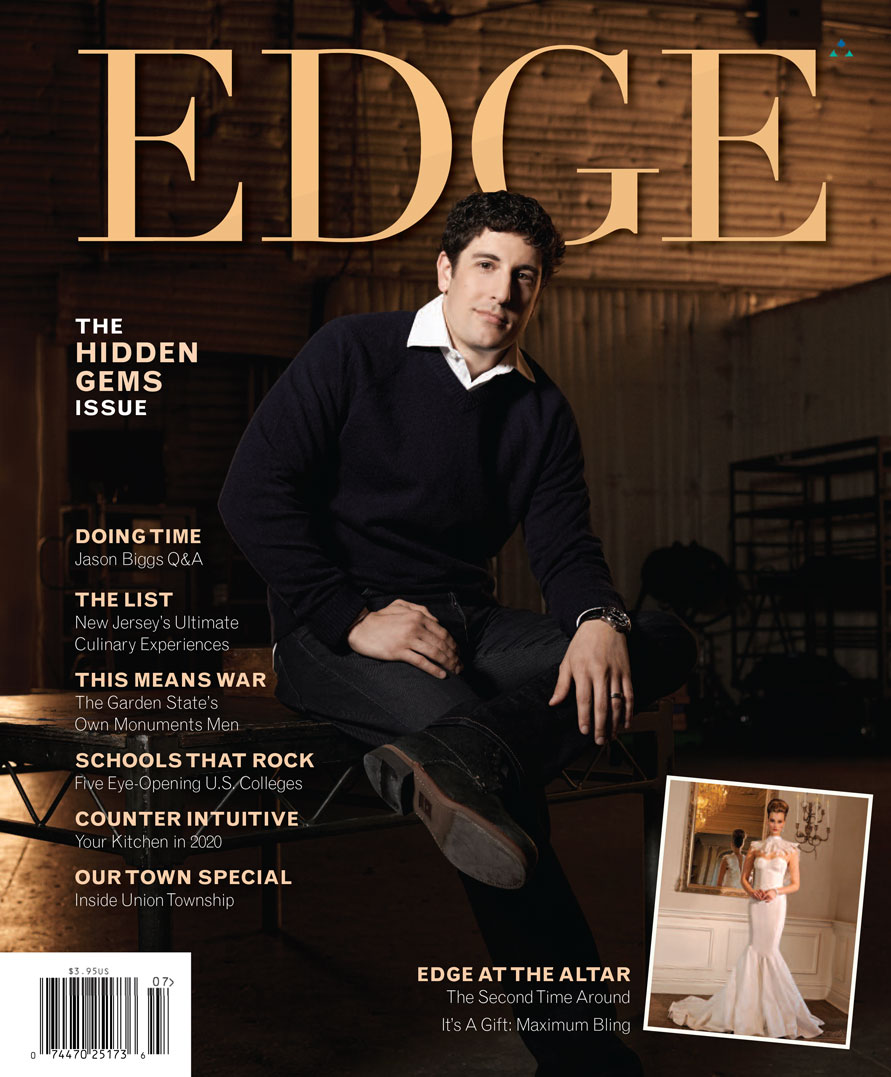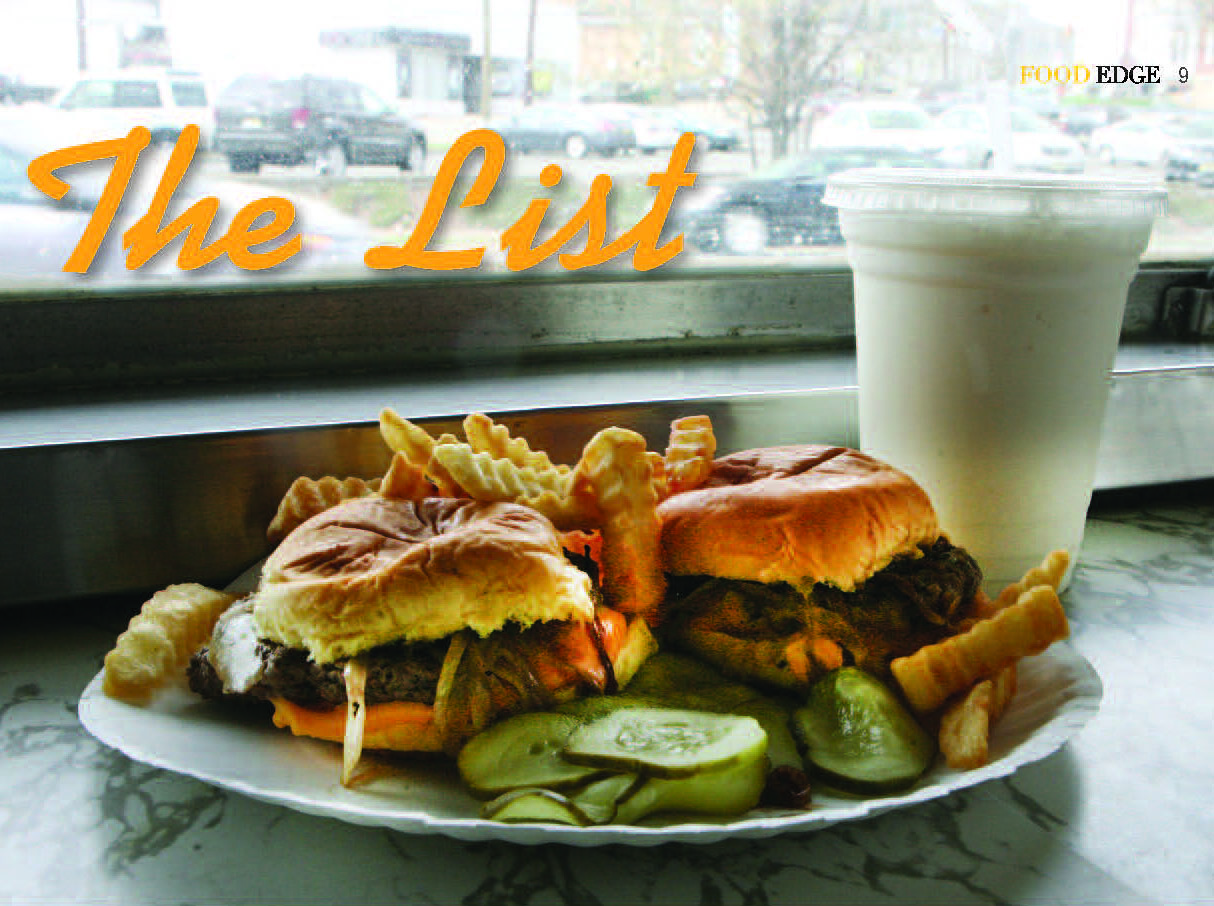Relax…let your nano-robots do the dishes
Speckled linoleum. Avocado appliances. Fluorescent lighting. These design tragedies are a distant memory compared to the contemporary kitchens of the 21st century. There’s no doubt about it: We’ve come a long way, baby. Yet, by 2020, the kitchen we are so proud of today may be just as outdated, antiquated and embarrassingly obsolete. And although the word kitchen will never entirely disappear from our vocabulary, it’s possible that we may be grasping for a new name that describes a room that plays a much more expanded role in our domestic surroundings.

Photos courtesy of Michael Harboun
If you have redone your kitchen in the past decade, you may be in for a rude awakening when the 2020’s hit. The state-of-the-art hallmarks that we so proudly (not to mention, expensively) included in our dream kitchens will seem like art only in the sense that some will belong in a museum. Indeed, the kitchen of the not-too-distant future will embrace science and technology as well as aesthetics.

Whirlpool already began previewing its Kitchen of 2020 at the recent Consumer Electronics Show (CES) in Las Vegas. One item in particular had kitchen remodelers dancing in the aisles: a refrigerator that will be Bluetooth-enabled to stream music into your kitchen. You will be able to coordinate your menu to an appropriate musical background at a tap of a finger. If it’s salsa your prepping, then salsa can be your music of choice. If it’s an elegant and high-end Beef Wellington, then something classical may be in order. Downhome spread? How about some Brad Paisley? No need to drag that iPod or iPad into your work area. That’s so 2013.
One day, by the way, your refrigerator may not even have a door—at least as we know it today. Instead, you’ll be able to push and pull your food through a see-through gel-like framework (hopefully tinted to coordinate with your color scheme). If you think this sounds like something out of a Jetsons cartoon, think again. To retrieve an item from the Bio Robot Fridge, all you will have to do is reach through an odorless, non-sticky polymer gel and pull it out. No more leaving that refrigerator door open or endlessly wiping off greasy little fingerprints. Russian student Yuriy Dmitriev took second place at the Electrolux Design Lab competition with this idea. Four years ago.
HOT TOPIC
One cannot discuss the Kitchen of 2020 without addressing its very essence, the stove. From huge cauldron-bearing hearths to black and bulky cast iron relics to built-in multi-burner tops, the kitchen remains first and foremost a place to cook. The word kitchen actually comes from the Old Latin word coquere, meaning “to cook”—which evolved into the Old English Cycene, to kichene in Middle English, to cucina in Europe, and eventually to our word. At its CES exhibit, another Whirlpool highlight was an induction cooktop designed to turn your countertop into a stove. Four dozen micro-inductors create one large cooking surface on which you can position up to four pots and pans. Since the heat is produced only where needed, the rest of the top stays cool to the touch. By the time this technology hits the market, there won’t be any control knobs; you’ll just tell the stove what you want it to do. Voice recognition technology will almost certainly be available on most appliances in 2020 and—perhaps more intriguingly—appliances may be talking back. Think about that for a second.
A go-green sensibility will also be part of new kitchens in 2020. Eco-clean, eco-friendly and eco-smart features will be available in almost every aspect of kitchen design. We might be looking at recycling sinks that hygienically reuse the same water supply, as well as more advanced versions of products that are already hitting the market: Nutrima (a foldable appliance to calculate nutritional values, possible toxins and food freshness), the Kitchen Hub (a food inventory and expiration monitor), the GE Advanced Filtration System (which removes 98% of important trace pharmaceuticals), and the LG Blast Chiller (five minutes to chill a can and eight for a bottle of wine).
Glass will almost certainly play an expanded role in the Kitchen of 2020. It is already becoming a popular design choice, replacing ceramic tiles above counters, sinks and stoves. However, in the next decade, we will begin to see glass used as part of energy solutions and not just aesthetics. There are plans afoot to use this material in roof and wall components that will funnel the power of the sun into kitchen appliances. We could also see glass-enclosed “living” walls that produce herbal greenery and edible fish and sea vegetation. The goal? To make the kitchen of the future a standalone, self-sufficient space that will reflect sustainability above all else.
GREAT EXPECTATIONS
When envisioning the Kitchen of 2020, one of the greatest challenges is separating fantasy from reality. It’s one thing to brainstorm and another to pick the brains of people in the know. Two individuals with hands-on knowledge of what’s actually waiting in the wings are Maria Stapperfenne and Brian Pagel. Stapperfenne is a Certified Kitchen and Bath Designer, President-Elect of the National Kitchen & Bath Association, and a Manager at Tewksbury Kitchens & Baths. Pagel, a VP of the Kitchen and Bath Group for Emerald Expositions—one of North America’s largest trade show producers—gets the ultimate sneak peak of future products as he works with exhibitors to showcase their most innovative kitchen components.
Stapperfenne shared what she learned on her recent travels to expos in Las Vegas, Los Angeles and Milan. She saw, up-close and personal, some technological “super products” and design concepts that may not be available by 2020, but which are certainly in the pipeline. Her enthusiasm for what’s to come is infectious (see page 26). At Eurocucina in Milan in April, she was allowed to photograph one of the aforementioned induction-type cooking spaces that has been seamlessly integrated into a countertop. Understandably, makers of advanced technologies can get touchy about photos; this was the exception that proved the rule.
According to Stapperfenne, most major kitchen renovations are being undertaken by people in the 30-to-50 age range. These clients often save up for years for a new kitchen, so naturally they expect their investment to last 20 years. Given the increasing speed of technological advances, the actual “lifespan” may be much more compressed. Which can make for some nervous customers. Consequently, Stapperfenne describes her professional mission as “educating our clients to make intelligent and informed decisions, and then to have confidence in their choices.”
Cost is another issue. According to Stapperfenne, a kitchen remodel is a reflection of individual budgeting. She found an exhibitor at the Milan show who indicated that the level of investment for his displayed 18’ x 20’ kitchen was somewhere between $495,000 and$500,000! When asked what she would want most in her own future kitchen design, Stapperfenne put comfort and convenience at the top of her list.
Brian Pagel feels that, despite all the technological advances, the Kitchen of 2020 will still reflect many of today’s design touchpoints—in other words, what’s in now won’t necessarily be out by then. However, for longer-range predictions, he believes emphasis will be placed on accessible living, aging in place and the “totally wired” kitchen, with technology as integrated as in the rest of the house. Pagel also predicts that manufacturing will focus on reclaimed, reused and eco-friendly materials, along with energy efficiency. His most recent exposition in Las Vegas, the 2014 Kitchen & Bath Industry Show, was a joint venture with the National Association of Home Builders. This co-sharing opportunity reflects his conviction that close collaboration between construction and design—with the added advances in technology—represents the future not just for the kitchen, but for the entire home.
ALWAYS A GATHERING PLACE
With all its cutting-edge electronic enhancements and techno-friendly gadgets, tomorrow’s smart kitchen will remain the hands-down favorite gathering space—where “gathering” is the operative word. Granted, a kitchen may no longer be defined by any distinct perimeters, and will almost certainly migrate into other functional areas of the home. However, as the designated area for food-focused activity, high-tech efficiency and social interaction, it will remain the heart and soul of our homes in 2020 and for generations to come.
 2020 & BEYOND
2020 & BEYOND
When Maria Stapperfenne looks into her crystal ball, this is what she sees…
Wireless Power
We will power up our kitchens as easily as we access our Wi-Fi connections elsewhere in the house today. Countertops will be equipped with conveniences like Duracell’s PowerMat, a built-in charging pad that makes plugs obsolete, and we’ll get wireless delivery of our morning newspaper simply by tapping on the counter surface.
Lower Maintenance
People generally don’t like to clean, so the trend in kitchens is to modern styling with less ornamentation and flowery crevices in which to catch dirt. Modern and minimalism go together.
Transiency
One day, you may be able to change the look of your kitchen as easily as you change your wardrobe. Kitchen cabinetry and appliances will no longer be permanently installed, but instead will be wall-hung for easy removal to minimize the labor and upheaval associated with kitchen remodeling.
Voice Recognition
With a simple code word, you will be able to turn on your lights, start your oven, or order your favorite latte.
Personalization, Organization and Accessibility
Cabinet shelves and drawers can be personally outfitted, right down to contour-specific routing and grooving as cradles for your personal cutlery and dishware. Another exhibit at the Milan exposition featured a center island complete with a built-in storage unit that rises from the counter via remote control for quick access, much like today’s lift cabinets that hide large flat-screen TVs.
 So what else will be in your kitchen in 2020 and beyond? Interactive cookbooks and recipes should be available on pop-up or drop-down video screens, or through tablets and other devices connected to your kitchen’s “brain.” There are folks looking at creating smart countertops with bio scanners that can assess your nutritional needs. Your fridge will keep track of what you’ve got, what you need, and what’s about to go bad—and connect with your smartphone when you’re at the grocery store. The most-used source of heat in your kitchen? It could very well be steam. And that smart countertop may include built-in extractors to transform the steam to water for other general uses after it flows through the heating element. Nothing wasted; everything gained.
So what else will be in your kitchen in 2020 and beyond? Interactive cookbooks and recipes should be available on pop-up or drop-down video screens, or through tablets and other devices connected to your kitchen’s “brain.” There are folks looking at creating smart countertops with bio scanners that can assess your nutritional needs. Your fridge will keep track of what you’ve got, what you need, and what’s about to go bad—and connect with your smartphone when you’re at the grocery store. The most-used source of heat in your kitchen? It could very well be steam. And that smart countertop may include built-in extractors to transform the steam to water for other general uses after it flows through the heating element. Nothing wasted; everything gained.
Speaking of water, Perez Zapata’s Mab, a first-place winner in the 2013 Electrolux Design Lab competition, is a futuristic system designed as a spherical hive of hundreds of small flying robot drones that clean surfaces just by touching them with a drop of water. Getting still more fantastical, Michaël Harboun’s Living Kitchen explores “claytronics,” which is basically a form of nanotechnology, where tiny little robots can arrange themselves into macroscopic structures that will let you create any forms out of a moldable mass. Touch the moldable mass and you will be able to pull out a faucet, scoop out a deep sink, or access any appliance on demand (google Harboun on youtube for a truly “unbelievable” video). And if it’s company you long for, laser hologram technology will let you invite your favorite chef into your kitchen or arrange a face-to-face cook-off with virtual friends and relatives. Virtual relatives…hmm. The kitchen of the future is sounding better and better!
 STEAM POWER
STEAM POWER
Whatever high-end kitchen solutions the future brings, it’s a pretty good bet that the Eardly T. Petersen Company will be involved in some aspect of floorcare and water filtration. Interestingly, the company carries one particular product that has been a component of cutting-edge kitchens for 35 years…and is likely to be there in another 35: The Ladybug. The beachball-shaped Dry Steam Vapor cleaner cuts through the biofilm created by bacteria on countertops without the use of chemicals or toxins. “Study after study shows that the kitchen is the most contaminated room in the home, and that bleach does not kill all bacteria,” Keith Petersen points out. “The Ladybug cleans and disinfects surfaces with ordinary tapwater heated to make a hot, dry steam. Countertops, floors, ovens, stoves, sinks, dishwashers, refrigerator interiors, windows, doors—it’s amazing.”
Since the 1950s, the Westfield-based company has identified, sold and serviced leading-edge products for inside and outside the home. The founder’s sons, Keith and Douglas, have doubled down on their father’s unbending commitment to quality, offering the most revered brands in the industry and backing them up with the human touch. “People look to us for our knowledge,” says Douglas. “They come to our retail location on Elmer Street and say, Wow, this is like an old-fashioned store. If we don’t think a product is the best in its industry, we won’t sell it.”
Two distinct menus have made Rella’s a ‘shore thing’.
 There is a rule of thumb in the restaurant business: Try to be everything to all people, and the best you’ll be is Applebee’s. The worst you’ll be is out of business. That being said, Rella’s Italian Tavern proves you can serve two masters, both literally and figuratively. The restaurant’s menu offers two ways to go (as its name implies), imaginative Italian cuisine or reliable tavern fare. Co-owner Sal Chiarella knows his way around both kitchens. He created and sold both the neighborhood go-to spot Harborside Grill in Atlantic Highlands and Fratello’s, a high-end Italian eatery in Sea Girt. Both are still going strong.
There is a rule of thumb in the restaurant business: Try to be everything to all people, and the best you’ll be is Applebee’s. The worst you’ll be is out of business. That being said, Rella’s Italian Tavern proves you can serve two masters, both literally and figuratively. The restaurant’s menu offers two ways to go (as its name implies), imaginative Italian cuisine or reliable tavern fare. Co-owner Sal Chiarella knows his way around both kitchens. He created and sold both the neighborhood go-to spot Harborside Grill in Atlantic Highlands and Fratello’s, a high-end Italian eatery in Sea Girt. Both are still going strong.
What Sal and his brother, Sam, learned from these successes was how to build a menu around both types of cuisine. The majority of patrons at Rella’s pick either Italian or tavern fare; a fair number mix and match. Our group—comprised of seven veteran Jersey Shore diners—agreed to explore the Italian side of Rella’s kitchen on a busy Thursday night.
If you are one of those people who skips the starters to save room for the main course, Rella’s definitely poses a dilemma. The entrée portions are ample, to say the least, however the front side of the menu packs a surprising amount of star power. Indeed, the descriptions don’t begin to do justice to items that shine once they hit the table. Case in point: artichoke Francaise. Nutty and tart, the lightly fried bite-size portions are packed with flavor without overwhelming the palate. Another winning item is the broccoli rabe and sausage stuffed bread. Out of the wood-burning oven and piping hot, it too is done with a surprisingly light touch. With sweet sausage on one side and peppery greens on the other, the two tastes speak for themselves, with just a bit of mozzarella to pull the whole appetizer together.
The hit parade continued with rack of lamb lollipops, a selection on the evening’s specials menu (but generally available). Enough for two, especially with the accompanying swirl of whipped potatoes, the two-bite pops are exceptionally flavorful and drizzled with a balsamic demiglaze.
Two members of our dining group had eaten at Rella’s before and raved about the eggplant rollatini appetizer (as well as the eggplant parmagiana listed among the entrées). We took their word for it and opted for the fried calamari instead. Lightly seasoned and domestically sourced, it is better than most but not extraordinary in and of itself. It’s the marinara sauce that’s the eye-opener. Fresh, tangy and uncomplicated, it plays a big part in the restaurant’s popularity. It elevates everything it touches.
At our table of seven, the home run starter, by unanimous agreement, was the blackened sea scallops salad. Served on a bed of mesculine with grape tomatoes, cucumbers, peppers and toasted almonds, the scallops were meaty, flavorful and done to perfection. Often, these types of salads are overdressed. Not so the ginger-soy dressing. Interestingly, no one at the table thought they would have ordered this item solely from its description. However, several said they would return to Rella’s just for a second shot at the salad.
Pizzas at Rella’s are available in traditional and personal size, with design-your-own toppings as well as tasty combinations like the two we ordered—prosciutto & baby Arugula and a basic Margherita. The crust is thin and the ingredients fresh, emerging from the aforementioned oven and rushed to the table still bubbling. Rella’s also has a “pizza bar,” which saw a lot of action on this night, when the Rangers and Flyers met to open the Stanley Cup Playoffs.
Hockey, for what it’s worth, is kind of a big deal here. From late October through the May/June postseason, Rella’s is a gathering place for NHL fans, who can position themselves in front of one of eight enormous flat-screens that we counted—including one in the main dining room. Our waiter, Nick, kept a close eye on our table but we also caught him keeping tabs on the action with his other eye. Later, he told me he was a hockey player as well as a fan.
The opening courses set the bar high for what followed—a parade of imaginatively conceived and prepared main courses served family-style. Rella’s prides itself on the big dish concept. It works well for some entrée choices and not for others. Chicken and fish can be tricky to get just right when you’re feeding an entire table. On this night, we agreed that individual orders would have been preferable for the herb-encrusted red snapper and chicken & sausage Scarpariello. That being said, both of these dishes packed plenty of flavor. The Scarpariello preparation is a classic country dish featuring copious amounts of herbs and garlic in a balsamic reduction, along with spicy sausage. Rella’s offers a choice of boneless or bone-in. Bone-in is the way to go. The snapper fillets sat atop a mound of delicious spaghetti squash and were finished with a sun-dried tomato beurre blanc. We did not sample the other fish special, Blackened Tuna.
It bears mentioning that the fish entrées at Rella’s are popular year-round. The Chiarella brothers have forged long relationships with local fishing fleets; when they hook a great swordfish or tuna specimen, Rella’s often get a heads-up via cell phone as the boats hit the docks. That being said, they choose not to compete with the summer shore restaurants on the lobster front. Although lobster may appear occasionally among the specials—and is always available in sauce form as a pairing with angliotti pasta—this is not one of those ubiquitous plastic-bib joints on the other side of the Manasquan River.
For our remaining entrées, we picked two pastas and the pork osso buco. Also, we deviated from our all-Italian strategy with the addition of chicken Murphy, which was not on the menu (nor among the specials), but which we were told could be made to order. Expecting a hefty breast portion buried under an avalanche of onions and peppers, we were pleasantly surprised at the level of restraint on the part of the kitchen staff, and the finesse with which the dish was prepared. The osso buco, a generously proportioned pork shank that falls off the bone, was accompanied by a mushroom risotto. We happened to eat at Rella’s on one of those chilly nights in April, so the heartiness of this dish was appreciated. On a humid summer evening, the carnivore in your party might look elsewhere on the menu—perhaps the New York Strip or even the breaded Veal Chop.
We selected two dishes that represented the extremes of the pasta spectrum at Rella’s: the house specialty (more on this in a moment) and goat cheese ravioli. The ravioli, ordered off the evening’s list of specials, was made in-house and combined roasted garlic and sun-dried tomatoes in a light, creamy arugula pesto sauce. Of all the entrées, the ravioli got the biggest thumbs-up. Even those among us who are not normally fans of goat cheese enjoyed an eyebrow-raising experience. As with the scallop salad, the description did not do this item justice. It was the evening’s hidden gem.
When asked which pasta entrée would be most likely to turn a first-timer into a regular, Sal pointed us toward the Sunday Macaroni. A bed of sturdy rigatoni supports a sauce that includes meatballs, brasciole, Italian sausage and pork spare ribs. The gravy itself has won the local Boss of the Sauce competition so many times that, rumor has it, Rella’s has been discouraged from entering it this year. The Sunday Macaroni may not appeal to diners who prefer a light touch, but to those who embrace the meat-eating experience, it is nothing short of an event. It hit our table family-style, so it is difficult to gauge what a single serving might look like. However, from a value perspective, it is hard to imagine anything at Rella’s topping this house specialty.
Which is an important part of the story at Rella’s. When Sal and Sam Chiarella decided to open their place in 2008, they agreed that they would offer a menu with lots of value. The day-to-day entrées are almost all between$15 and $25, while “higher-end” dishes only find their way onto the nightly specials if they can be offered within those price points. Starters range in price from $5 to $15, while desserts—though extravagantly plated—are also reasonably priced.
Ah, dessert. If possible, save room—just a little room. Italian restaurants can be pretty heavy-handed in this department, but not so Rella’s. The table produced a collective groan when Nick the waiter reviewed the dessert selections, but we were assured that two of the richest-sounding items were actually light enough to pass around with multiple spoons. Nick was a man of his word. The Almond Cake had a feathery texture and a complex combination of flavors. The Chocolate Lava Cake was also surprisingly light without being overly volcanic. Rella’s also offers Mama Rella’s Cheesecake (a family recipe) and a popular Tartufo.
 ON THE TAVERN SIDE
ON THE TAVERN SIDE
Rella’s would not be the success it is (you can barely squeeze in on most Friday and Saturday nights) without a menu that brings in a diverse and devoted clientele. The space itself offers a number of different dining experiences. To the right of the hostess station is a pair of warm, subdued rooms featuring open hearths. To the left, it’s a less formal atmosphere, with cocktail tables, booths, a u-shaped bar and the aforementioned pizza bar and scattering of flat-screen TVs. The entire menu—specials and all—is available throughout the restaurant.
An important word about wings, if that’s your thing…normally, connoisseurs of bar food steer clear of chicken wings at Italian restaurants. At Rella’s, the patrons swear by them. Besides Buffalo and BBQ wings, the kitchen also prepares them with garlic and parmesan, as well as Scarpariello style. Sliders (with a choice of meatball, sirloin or chicken parm) are also popular.
Rella’s makes a wide range of paninis and wraps, as well as a signature Prime Rib French Dip. Pizzas of all sizes and varieties fly out of the wood-burning oven, as do calzones, with a selection of toppings above-average in both quantity and quality. The wine list has good options at all price levels and there are over a dozen beers on tap.
Editor’s Note: Rella’s Italian Tavern is located at 110 Union Avenue (aka Rte 71). In Brielle. The restaurant is open at 3:00 p.m. Monday through Friday, and at 11:30 on Saturday and Sunday. Rella’s has two spaces that can be reserved for private parties or business gatherings. Call (732) 528–0034 or log onto rellastavern.com for more information. Special thanks to Gary and Joanie Brown, Terri and Tim Russell, Maria Dabroski and Sarah Wilson.
Watches with an EDGE
 FIT FOR A KING
FIT FOR A KING
Classic styling with a fresh, casual feel make the Royal Oak Offshore Chronograph a true standout timepiece. Available at audemarspiguet.com.
 LINE ITEM
LINE ITEM
The Ora Unica Watch, by Denis Guidone for Nava Design, tells time with the ends of the signature squiggle. Available at shop.walkerart.org.
 ALL THAT GLITTERS
ALL THAT GLITTERS
A gold-sprinkled dial with the iconic signature dot helps the Movado Bold Glitter Watch stand out in a crowd. Available at nordstrom.com.
 PETAL TO THE METAL
PETAL TO THE METAL
The diamond-studded mother of pearl Floral Watch features Art Deco styling and an interchangeable strap. Available at michele.com.
 NUMBERS GAME
NUMBERS GAME
Keep your eye on the hands, not the numbers, of the What Time? Watch from Rakani. Available at rakani.com.
 FAIR & SQUARE
FAIR & SQUARE
The rugged men’s Block Watch is stamped in squared-off brass surrounding a circular face. Available at shop.walkerart.org.
Rings with an EDGE
 ENDLESS LOVE
ENDLESS LOVE
The Infinity Ring circles endlessly, finishing with an exquisite Japanese Akoya black pearl at its focal point. Available at artfulhome.com.
 SPRING FEVER
SPRING FEVER
Mikimoto’s Spring Ring sets off a perfectly cultured pearl with a burst of sapphires, tourmalines, amethysts, and diamonds. Available at mikimotoamerica.com.
 GOLD FINGER
GOLD FINGER
The Erica Courtney Wrap Ring combines gold and green tourmaline in a trend-setting modern design. Available at ericacourtney.com.
 SIMPLY BRILLIANT
SIMPLY BRILLIANT
The bold and smashing Sapphire Ring from Brilliant Earth showcases a beautiful blue sapphire center gem with a halo of diamonds. Available at brilliantearth.com.
 FUTURE PERFECT
FUTURE PERFECT
The avant-garde Palladium Ring features a baroque pearl raised to new heights by a surround of white and yellow diamonds. Available at markschneiderdesign.com.
 TRUE COLORS
TRUE COLORS
The joyfully constructed Szor Collection Celebration Ring features rose-cut sapphires in a gold setting.
Available at 1stdibs.com.
Jewelry with and EDGE
CURIOUS YELLOW
This Hand-Knotted Necklace features a double-strand of chunky jasper. Available at neimanmarcus.com.
DECO RATED
These Sterling & Gold Earrings with onyx and garnet celebrate the industrial design of the Art Deco era. Available at artfulhome.com.
LIFT OFF
Anna Tai’s playful cloisonné Rocket Brooch frames an oval cabochon amethyst among floating celestial bodies. Available at artfulhome.com.
IN FLIGHT
Mark Schneider’s Montana Agate Phoenix Pendant features pavé diamonds and a ruby eye. Available at markschneiderdesign.com.
SEA CHANGE
You may not hear the ocean in these turquoise-and-diamond Anuj Carved Shell Earrings, but the oohs and aahs will come through loud and clear. Available at 1stdibs.com.
POWER UP
The Alex and Ani Energy Bracelet is part of the sizzling-hot wrist wear trend. Available at alexandani.com.
Pearls with an EDGE
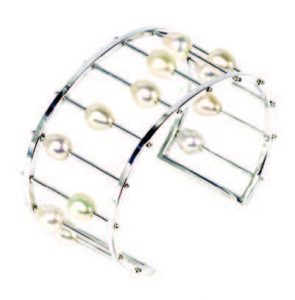 MAKE IT COUNT
MAKE IT COUNT
Movable pear-shaped cultured freshwater pearls give the hand-crafted Abacus Cuff its name. Available at artfulhome.com.
 PURPLE PASSION
PURPLE PASSION
Designed by Sukanya Thongper of Bangkok, this opulent Snow Iris Amethyst and Pearl Choker evokes the colors of a garden favorite. Available at novica.com.
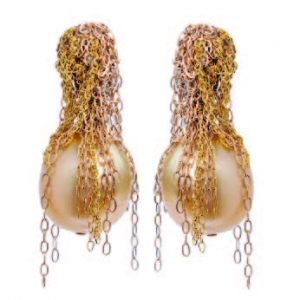 NET GAINS
NET GAINS
Designer Martin Bernstein envelopes luminous South Sea Pearl Earrings in a gorgeous tangle of tri-color gold and sterling chain. Available at greenwichjewelers.com.
 CRAZY 8’S
CRAZY 8’S
Mikimoto’s Moderna 8 Earrings are a compelling fusion of exquisite Italian design with faultless cultured pearls. Available at mikimotoamerica.com.
 SWING TIME
SWING TIME
Renee Lewis created these magnificent South Sea Pearl & Diamond Dangle Earrings as part of a collection for Barneys. Available at Barneys.com.
Nazi art thieves were no match for New Jersey’s real-life Monuments Men
Over the past year, the brave men and women who devoted their knowledge and efforts to save the looted masterpieces of Western civilization during World War II have risen—mostly from the dead—into the public eye more than 70 years later. The art-specialist soldiers known as “Monuments Men” marched out of history’s shadows and right into popular culture thanks to the movie starring George Clooney, John Goodman, Bill Murray and friends. Unbeknownst to all but a handful of historians, many of these heroic, dedicated and patriotic academics—who raced against time (and the Russians) to save the great masterpieces and hidden gems of the Western world—lived, worked and trained in the Garden State.

Columbia Pictures/Fox 2000 Pictures
Among the key players in this story who hailed from our state were S. Lane Faison, Charles Parkhurst, Patrick Kelleher, Ernest DeWald and Craig Hugh Smyth, who studied at Princeton to be art historians and curators. A handful of these distinguished men went on to be directors of the Princeton University Museum of Art.
The Monuments, Fine Arts and Archives Commission (MFAA), a group of 345 men and women from 13 nations, was established in 1943 as the tide of war began to turn in Europe. Known as the Monuments Men, they were recruited and trained to retrieve, safeguard and return art masterpieces, many of which had been looted from museums or confiscated from Jewish families. The Hollywood film is an amalgam of people and events. In the race to save civilization, lives and irreplaceable masterpieces, real-life art historians and curators in Europe and the United States actually began their work more than four years before Germany even declared war, and continued their endeavors for many years after the Nazis were defeated.
In anticipation of the war, museums all over Europe toiled day and night, carefully packing up sculptures and paintings and shipping them to hiding places. It was a national effort. For larger paintings, the Louvre employed scenery trucks from the Comedie-Francaise to transport them to shelters. The Mona Lisa was chauffeured in its own private railway car to her hiding place in a French chateau in the Dordogne. In 1941, the United States followed suit. Art treasures, from the newly established National Museum of Art in Washington, for example, were shipped to the safety of The Biltmore in North Carolina, as well as Fort Knox.
THE DOCTOR IS IN
The aforementioned Dr. Smyth (pictured in uniform on the preceding page) was one of the young curators who helped to move the art. A Naval reservist with bachelor’s and master’s degrees in art history from Princeton, he served as a drill sergeant and officer in the Pacific before he was tapped to head the Munich Collecting Point out of Hitler’s Munich Headquarters. Smyth’s story begins mostly when Monuments Men, the movie, ends.
According to Alexandra Smyth, his daughter, Dr. Smyth settled into Hitler’s office at the Nazi headquarters—now, appropriately, the Central Institute of Art History—as “it was the only building large enough to house the huge amounts of art for cataloguing and repatriation.” Dr. Smyth, who spoke German, immediately incurred the wrath of the U.S. military for hiring knowledgeable Germans to help with the daunting task of sorting, cataloguing and returning the tens of thousands of art treasures that were being trucked in from their hiding places—including those poorly stored in the dank salt mines shown in the 2014 movie.
“He felt it was his duty,” notes his son, Ned Smyth, “to reignite German interest in art—he considered Germany the intellectual birthplace of art history—and reawaken a positive patriotic identity of German intellectual tradition of art history…and so he hired German art experts, who were cleared by the military, to help with identifying and returning the plundered treasures.”
Eyebrows also were raised when Dr. Smyth retained the services of the German custodian who had previously maintained the Nazi headquarters for Hitler. According to his son, he wanted to get qualified Germans back to work. Later, Dr. Smyth made a point to hire German Jewish art historians to work at The Institute of Fine Arts in New York.

Photo courtesy of the Smyth family
The question of whether to return the artwork to its European owners or to send it to the U.S. for “safe-keeping” was another prickly issue. The Russians, considered any art they found as spoils of war—compensation for the devastation visited upon them by the German military—and shipped vast quantities back to Moscow. The race to seize as much of the art before it disappeared into Russian hands was one of the main plotlines in the movie.

The priceless Madonna of Bruges: loaded for transport (top) and back home in The Church of Our Lady in Belgium (bottom).
UNLIKE IKE
Dr. Smyth strongly favored returning the masterpieces to the original owners or their surviving family members. However, not all the Monuments Men agreed. John Walker, a director of the National Gallery, saw the Collecting Points as convenient way stations to appropriate European masterpieces for his new museum. He convinced General Dwight D. Eisenhower that the art should be shipped to the United States. This set up a High Noon moment that would have provided a high point for the film.
“When Eisenhower arrived at the Munich Collecting Point,” Ned Smyth recounts, “Dad had the army soldiers stationed carrying machine guns guarding the head-quarters. My dad spoke with Eisenhower…and he got the message. If anything my dad did during the war captured my young imagination, it was how he risked court-martial and the end of a promising career to save the art for Europe.”
Dr. Smyth, who passed away in 2006, lived in Alpine and went on to earn his PhD from Princeton and enjoyed a distinguished career as Director of the Institute of Fine Arts at NYU and Director of the Harvard Center for Italian Renaissance Studies at Villa I Tatti near Florence. He also was an honorary trustee of the Metropolitan Museum of Art. His efforts in restoration of art in Europe earned him honors in both France and Germany.
WILD ABOUT HARRY
The last of the Monuments Men, 88-year-old Harry Ettlinger (pictured on page 71), lives in the Morris County town of Rockaway. Born in Germany to an affluent Jewish family, he escaped to America with his parents and siblings, starting their new life in a one-room apartment in Washington Heights.
“People told my father Go West,” Ettlinger jokes. “So we moved west…16 miles to New Jersey.”
When he returned to Germany during World War II, it was as a citizen of the United States and a soldier of its armed forces. As an army private, he was plucked from his company (which was heading to the Battle of the Bulge) to help translate for the Monuments Men. His take on the movie—where his name was changed to Sam Epstein and the handsome British actor Dimitri Leonidas portrayed him—is that it was entertaining and educational, but “to a degree, they have covered certain items that reflect what Monuments Men did. The rest is Hollywood.”
While we may feel it, not many of us actually can say we worked in the salt mines. But that’s what Ettlinger did after Germany’s surrender. For ten months he oversaw the removal of artworks that had been stored by the Nazis 700 feet below ground in salt mines to protect them from Allied bombs. There among the treasures, Ettlinger and the German miners—who had been okayed by the United States—uncovered the stained glass windows of the Cathedral of Strasburg as well as a Rembrandt self-portrait. In addition, he helped with art retrieval from Hitler’s private retreat, the Eagle’s Nest. He also helped recover and return works of art owned by the French branch of the Rothschild family, which had been stored in Neuschwanstein Castle in the Bavarian Alps.
Perhaps the most meaningful moment in this experience was retrieving his grandfather Oppenheimer’s collection from a warehouse in the Swiss spa town of Baden Baden. Ettlinger, who went on to a distinguished career as an engineer, says his grandfather was a wise man, known for his humor—wonderful traits that seem to run in the family.

Neue Gallerie NYC
DEGENERATE ART
The Nazis’ aesthetic was intolerant towards modern art and termed it “degenerate.” Hermann Goering was charged with identifying and rounding up potentially important modern works to be sold to collectors outside Germany. This plan met with little success, and at one point an exhibition was held in Munich so that Nazi leaders could make fun of the paintings. After that, the art was supposedly burned. Much of what survived was only recently retrieved from apartments owned by the late Cornelius Gurlitt, the son of one of Hitler’s hand-picked Modern Art confiscation experts. The elder Gurlitt was tasked by the Nazis with selling the looted art through his network of contacts. Already, a valuable Matisse painting from that cache was returned to art dealer Paul Rosenberg’s descendants, one of whom is Anne Sinclair, the ex-wife of Dominique Strauss-Kahn (aka DSK), the former managing director of the World Monetary Fund. Earlier this spring, the Neue Gallerie in New York mounted a show exhibiting the stunning Degenerate Art seized by the Nazis from museums and private collections.

Internationale Filmfestspiele Berlin
Whether The Monuments Men and its attendant publicity inspired people to come forward with knowledge of artwork looted or “lost” during World War II, it seems every week brings a new discovery and reunion of art with owner. Just this past April, a 17th Century painting missing during the war was sent from Germany back to Poland. And, of course, there was the startling headline last November about 1,500 works of art that were discovered behind a wall of canned food in a Munich flat. Thus the legacy of the Monuments Men is nothing if not enduring.
Editor’s Note: Sarah Rossbach grew up with stories of those who escaped the Nazi regime and those who, sadly, did not. One of the lucky German Jews, Robert von Hirsch, traded a 16th Century Cranach painting for the right to leave Germany alive with the rest of his collection. His brother, who collected original sheet music, received exit visas for himself and his family, but was ordered to leave the sheet music in Germany. His wife successfully petitioned to take her everyday china. She wrapped it in—what else?—priceless sheet music by Beethoven, Brahms and Bach.
There’s a hidden gem waiting to be discovered by your college-bound teen

Photo by Mark Olencki
One of my most important tasks as an independent educational consultant is the development of a list of colleges appropriate to each student who walks into my office. I must consider the qualifications of a student—grades, the rigor of high school classes, test scores, activities, unique gifts and attributes as a candidate, and so on. I also think about the student’s preferences in colleges—big or small, East or West or North or South, highly pressurized or more laid back, religious or not. A consultant has to be sensitive to other factors, such as cost or special services. In the end, people in my profession seek that sometimes-elusive, but always crucial, love match.
Some list builders look to familiar, name-recognition colleges and universities. In some cases, this is done to the detriment of schools that—while not enjoying mainstream popularity—truly provide a transformative learning environment. There is no set list of these hidden gems; that depends on a combination of a student’s profile and a consultant’s knowledge of colleges. Making that list and checking it twice, well, even for a professional, it’s a labor-intensive process.
Let’s look at a hypothetical student, and how I go about creating a short list of hidden-gem schools. Your own college-bound teen may share many of these qualities or just a few. The important thing is to gain insight into the factors that contribute to a solid group of possibilities—so keep your eyes and minds open! I would like to credit my colleague, Dr. Steve Antonoff, for the case study summarized below—a junior whom we’ll call Emma—which we utilize in our UC Irvine online class, Principles of Educational Consulting:
Emma works hard for her grades at a moderately competitive public high school in a suburb of a large metropolitan city. She’s an interesting person. She has studied Chinese on her own, likes drafting, is into martial arts, and enjoys outdoor life. She clearly prefers cooperation to competition. She’s a low-key, introspective type. Emma wants to find the right match and wants something off the beaten path. Emma wants a small-to-medium-sized school. She prefers personal interaction between student and teacher. Very self-aware, she knows that she needs to be involved to be interested.
Emma’s activities include Cross-Country—all 4 years of high school—Track, Key Club, Stagecraft (about two shows per year), Theatre Company Club, Student Council officer in senior year, NHS, Aikido, African Drumming, Film Production (and viewing), and Snowboarding.
Emma likes arts and is considering a career in architecture or engineering, but wants a broad liberal arts education as an undergraduate. She seeks a balance between academic and social life and a school that’s not cutthroat. She does not want Greek life or for the college culture to be spectator-sports focused. Emma expects the people at her college to be creative, energetic (yet laid-back), scholarly, and supportive.
Emma has said, “The fit of the college is more important than the name/prestige. In fact, the prestige of the college means nothing to me.” She also wants to avoid schools with set cliques and social groups. Ideally, she would like to be close to mountains and/or an ocean. Access to a major city would be nice. She does not want abysmal weather. Her GPA is a 3.8 (approximate unweighted), her class rank is 38/475 and on her first ACT, she scored a 29. By her senior year, she’ll have several AP classes and most of her high school transcript contains accelerated courses. She has written her essay on her interest in Chinese language and culture.
Wow. Where do you start? There are approximately 4,000 four-year undergraduate colleges in the U.S., so the choices are abundant. In Emma’s case, I have left geography open; most students I see in my office do have geographic limitations—placed on them by themselves or parents—as to how far they may travel to attend college. Some (and in many years, most) have financial restrictions, as well. For our purposes, however, we’ll set cost aside. Here are five under-the-radar/ahead-of-the-curve schools that I believe would be a nice fit:
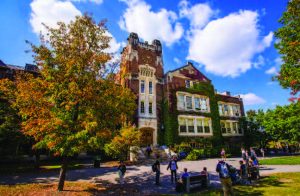
Photo by Keith Walters
SUNY Geneseo • New York 5
A little gem hidden in the Finger Lakes region of western
New York state, SUNY Geneseo is still not on many applicants’ radar. At a mere $10,000 per year for out-of-state students, Emma’s parents will be rubbing their eyes in disbelief. Complete with a quaint Main Street walkable from campus, SUNY Geneseo boasts a reputation as the “honors college” of the SUNY system (without the zero-sum game of most selective institutions). Leadership and a small, liberal-arts size and feel—with access to the great outdoors—makes this a very nice find for Emma.

Photo by Mark Olencki
Wofford College • South Carolina 5
Wofford is the little darling of many Southern in-the-know families, but doesn’t seem to hold the same reputation in the North…yet. A small community of 1,500 undergraduates may be the reason. Up North, we drive by a dozen liberal arts colleges during our morning commute alone, but in South Carolina, Wofford resembles a Northern liberal arts college. Southerners seem to like the slightly conservative feel of the campus, the lack of cliques, and the location of Spartanburg, an up-and-coming growing community amongst young professionals. There is much to do and see, and with access to major airports—and other recognizable universities in close proximity—Emma should at least attend an information session to see if she can envision herself here for four years. Don’t expect a bargain price-wise, as is the case with some other Southern institutions. A solid $50,000 all-told is what you’ll pay per year for this excellent education.
 Lewis & Clark College • Oregon
Lewis & Clark College • Oregon
Lewis and Clark in Portland is right up Emma’s alley. While the average class size is 19, there are also several noted graduate-school programs that add to the academic mix. L&C self-identifies as seeking “independently minded scholars who thrive with a challenge.” This fits Emma’s personality and desire to be fully engaged in her learning. In these times of great uncertainty with college admissions, a student applying from another geographic location entirely could be an attractive attribute for a school that is more regionally recognized in the Northwest.
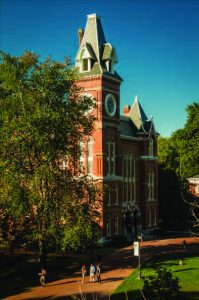
Photo by Tom England
Oxford College • Georgia 4
Oxford ranks as a hidden gem for a very hot reason: if admitted, the 950 students get to join Emory University in Atlanta as juniors, or remain on the Oxford campus (25 miles from Emory) for the remainder of their undergraduate studies. Small liberal arts—with a big university awaiting should a student choose—offers something unique in the college landscape. Emma would thrive in the small Oxford environment initially and be able to opt for something bigger should she desire more diversity or intellectual stimulation as her major and career aspirations develop. Drive due North from Atlanta and in two hours, Emma could be hiking the Appalachian trail or whitewater rafting in Rabun Gap, an outdoor enthusiast’s wonderland.
 Georgian Court University • New Jersey 5
Georgian Court University • New Jersey 5
Here’s something new for the college-savvy prospective student: GCU just went coeducational last fall, previously remaining all-female since its founding in 1908. The historic campus was formerly owned by the late George Jay Gould, whose father, a rail road entrepreneur, was once the ninth richest man in America! Complete with a Japanese garden, a “real” tennis court (there are less than a dozen of these historic courts in the world!) and an arboretum, this gorgeous campus is enjoyed by approximately 1600 undergraduates and under 1000 graduate students. A Catholic college in the Mercy tradition ensures a quality education that differentiates itself with intentional values-infused courses taught by extremely dedicated faculty. Minutes from the beach, Emma will enjoy weekends at the Jersey Shore. EDGE
Editor’s Note: Erin Avery founded Avery Educational Resources (@averyeducation) in 2003. She is a Certified Educational Planner who specializes in college and boarding school admissions. Avery holds degrees from the Peddie School, Boston College, Oxford University, Yale University and is currently completing a doctorate at Drew University in Madison. She notes that New Jersey is practically bursting with hidden gems, but in the spirit of variety, only one was included in this story. In addition to the in-state school mentioned, the author also identified Drew University, Bloomfield College, Felician College, Saint Peter’s University and the New Jersey Institute of Technology as potentially intriguing fits.
HOT FUN IN THE SUMMER TIME
Many families ask if campus visits are a waste of time if done during the summer. With the increase in student commitments, both athletic and extra-curricular—combined with the desire not to miss school days and risk falling behind—school breaks simply do not allow for enough time to conduct comprehensive campus visits. Seeing campuses while students are present is preferred, however summer time should also be used to explore. If it is truly a good match, following up with college social media connections and admission representatives can help to clarify any questions about student culture and fit.
ICING ON THE CAKE!
Trinitas celebrated its Top Hospital designation from Castle Connolly Ltd. as a top Hospital Overall and in the categories of breast cancer, prostate cancer, treatment of congestive heart failure, high risk pregnancy and high patient satisfaction rates in doctor communication and cleanliness. At all three campuses, everyone enjoyed a slice of cake like this one that LaVerne Tucker and George Amabile of the New Point campus show off for the camera.
 ALL IN THE FAMILY
ALL IN THE FAMILY
Ophthalmologist and cataract surgeon Dr. Corey Notis and his son, Alex, collect a load of supplies at the Guayaquil airport in Ecuador. Dr. Notis recently took time off from his offices in Springfield, Union and Linden to embark on a medical mission to Guayaquil. Dr. Notis was accompanied by Alex and his wife, Bonnie, both of whom are fluent in Spanish. They assisted with interpretation for patients and their families. Corey, Bonnie and Alex arrived with 10 boxes of much-needed clothing, books, school supplies and medication—much of it collected by students at Tenafly High, where Alex is a sophomore. The Notis family volunteered at a medical clinic in the country’s most populous city under the auspices of SEE (Surgical Eye Expeditions) International. Over the past 40 years, SEE has facilitated more than 400,000 surgeries in developing countries.
 POWER PLAYER
POWER PLAYER
Gary S. Horan, FACHE, President & CEO of Trinitas, is among an elite group of New Jersey health-care executives in the prestigious Power 50 in Healthcare list deter m i n e d by NJBIZ. His ranking of #29 rests on his ability “to effectively lead Trinitas in a challenging environment” as a single entity urban hospital. NJBIZ further reported that “Trinitas boasts a recently-opened $5.2 million Ambulatory Surgery Center and the nationally-recognized Trinitas School of Nursing. Horan has also served as the first non-New York chairman of the Greater New York Hospital Association.” According to an industry insider, “He’s done an unbelievable job of shepherding an urban hospital, proving it can be done.”
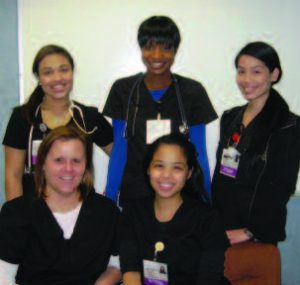 DESIGNED FOR NURSES
DESIGNED FOR NURSES
Two residency programs for novice nurses at Trinitas acquaint them with Emergency and Medical Surgical Nursing through a care-fully-designed 12-week program described as “a strong option for motivated nurses.”
 COLON HEALTH… FROM A TO Z
COLON HEALTH… FROM A TO Z
Andrea Zimmern, MD, colorectal surgeon at Trinitas, pauses for a photo with Elizabeth Rotary Club president Jim Duffy (left) and Rotary member Doug Harris, Vice President/Marketing & Public Relations. A graduate of New York Medical College, Dr. Zimmern joined Trinitas in 2011 where she initiated a complete colorectal surgery program including the latest treatment procedures using robotic surgery. She spoke to the club about colorectal health, risk factors and disease treatment.
 A LOOK INSIDE TRINITAS
A LOOK INSIDE TRINITAS
Juniors at Benedictine Academy in Elizabeth concluded a four-day immersion in the Emergency Department, Speech Therapy, the Cancer Center, Pediatric Health Center, Maternal/Child Health, the Pharmacy, and Diagnostic Imaging at Trinitas. They experienced the hospital setting and saw how departments work together to help patients.
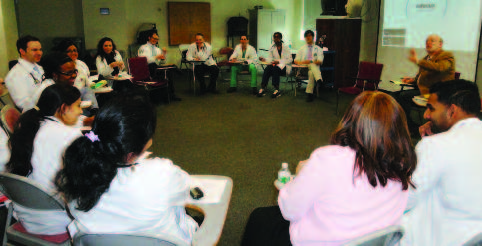 BEYOND MEDICINE
BEYOND MEDICINE
Richard J. Newman, professor of English at Nassau Community College in Garden City, NY, (at far right, facing group), conducted a “Poetry Heals” workshop for Trinitas medical residents. Partic-ipants stepped outside of the box to consider poetry’s potential to enrich their professional lives.
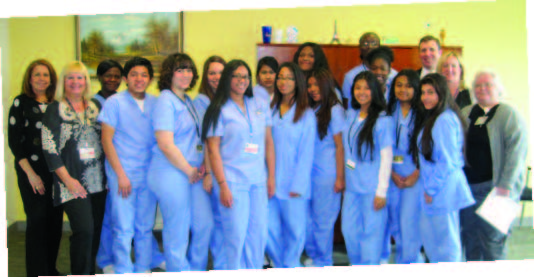 SHADOWING GETS AN A+
SHADOWING GETS AN A+
Now in its 10th consecutive year, students from Abraham Clark High School in Roselle participated in a five month-long program to observe and work side-by-side with Trinitas employees in a “shadowing” experience. This insider’s look gave them a deeper understanding of healthcare.





News, views and insights on maintaining a healthy edge.
 They Do More Than Play Football at LSU
They Do More Than Play Football at LSU
The health benefits of dark chocolate have been shown in study after study. Thanks to researchers at Louisiana State University, we now understand why. The good microbes in our colon, specifically Bifidobacterium and lactic acid bacteria, love the chocolate compounds that our bodies are unable to break down. As they digest the cocoa fibers, they produce new compounds that are able to be absorbed by our bodies. These compounds lessen the inflammation of cardiovascular tissue.
 The Five-Second Rule: A Second Look
The Five-Second Rule: A Second Look
Is it okay to consume food dropped on the floor if it’s picked up within five seconds? A team of British biology students have the answer to this question: It depends on the food…and the floor. The study, conducted at Aston University, measured the transfer of bacteria—specifically E. coli and Staphylococcus—on a variety of foods dropped on a variety of flooring for between 3 and 30 seconds. Wet and sticky food, such as noodles and candy, attracted the most bacteria. Carpeting proved to be “safer” (if you don’t mind the fibers and grit) than tile and laminate flooring. Not surprisingly, the longer food stayed on the floor, the more bacteria it attracted. In other words, you’re much better off plucking a chip off the carpet than consuming a chicken leg that tumbled off the kitchen counter.
 Surprising Findings in Oral Cancer Study
Surprising Findings in Oral Cancer Study
A joint study conducted by researchers in Germany and Scotland looked at the relationship between oral health behavior and the risk of developing cancers of the mouth and throat. Nearly 4,000 individuals were involved in the study. The results, published in Oral Oncology, turned up one really surprising piece of information. Heavy users of mouthwash—for example, three times a day—appeared to have a higher risk of cancer than those who brushed regularly but used mouthwash infrequently or not at all. The research team did not analyze the types of mouthwashes being used, and stated that this finding required further research. Another interesting conclusion the study drew was that denture wearers were at the same risk of developing serious oral problems as non-denture wearers if they did not schedule regular dental office visits. “Over the years, a number of studies such as this one have suggested that there may be a correlation between excessive use of mouthwash and the development of cancers of the mouth and throat,”

Barry Levinson, MD
Medical Director, Trinitas Comprehensive Cancer Center 908.994.8772
Barry Levinson, MD, Medical Director of the Trinitas Comprehensive Cancer Center points out. “It appears that the number of patients in this study who fell into the category of excessive users of mouthwash did not present enough statistical significance for the study to lend any strong support to drawing a connection to cancers of the mouth and throat. Smoking, drinking, and overall poor oral hygiene are much more important factors that lead to the development of oral cancer.”
 Home Games
Home Games
When we think of common musculoskeletal injuries, we tend to picture weekend warriors writhing in pain with fractures and tears suffered on a court or playing field. The truth is that about half of all musculoskeletal injuries occur at home. Sprains, strains and other soft-tissue injuries are actually the most common musculoskeletal injuries. They can cause a significant amount of pain, dysfunction, and disability and are also a major source of time missed from work, school, and recreation—which burdens both the individual and the healthcare system. According to

Christopher R. Ropiak, MD Union County Orthopaedic Group 908.486.1111
Dr. Christopher Ropiak of the Union County Orthopedic Group, many of the more common home-based injuries occur due to repetitive motion or significant straining in the setting of poorly conditioned or underprepared muscles. Consequently, many injuries might be prevented by routine and regular fitness programs, especially those that focus on core muscle strength and functional movements. “Even among people that do exercise regularly, too many of us focus on exercises that do not translate well into everyday life,” Dr. Ropiak points out. “While there are some benefits to body building or long hours on the elliptical machine, these types of exercises are often not very helpful in avoiding common injuries like back strains, muscle tears, etc.” Going to a gym or a trainer is great but for many of us, he adds, due to time and money constraints, that is just not a realistic option for everyone. Dr. Ropiak encourages his patients to explore some of the home-exercise programs that require a fraction of the time and money that it takes to go to the gym…“and might keep you out of the doctor’s office.”
 Number One Not So Fun
Number One Not So Fun
Time to break out the “purple dye”…it turns out that peeing in the pool can actually create a significant health hazard. New findings from a study at Purdue University confirm that uric acid, when mixed with common pool chemicals (including chlorine), can actually create dangerous compounds—including called cyanogen chloride, which is toxic to organs when inhaled, and trichloramine, which can injure the lungs. “Parents need to educate themselves—as well as their children—about public health and safety issues,” says

Kevin Lukenda, MD
Chairman of Family Medicine, Trinitas Regional Medical Center 908.925.9309
Dr. Kevin Lukenda, Chairman of Family Medicine at Trinitas. “They should stress the basics of hygiene: the importance of frequent hand-washing and sanitizing, the proper handling of paper money, shared cell phone use, and of course, ‘peeing in the pool.’ All are potential health risks that can be avoided through proper education.” Urinating in the pool is controllable behavior but we all know people do it anyway assuming it’s harmless. Well, it’s not. Who are the worst offenders? Competitive swimmers. P.S. They don’t fall for the old purple dye trick.
If your urologist seems busier than usual, well, there’s a reason for that…actually, there are three reasons
Urologists tend to fly under the radar. As a rule, their patients are not keen on discussing the problems and procedures with which they are involved in social situations. And, let’s face it: you don’t see a urologist unless you have to. Indeed, most people receive their AARP card before scheduling their first urological visit. So it’s worth paying attention when the profession pushes its way into the news—as it has in the last year or so.
Recent breakthroughs—and controversies—promise to alter the way urology practices interact with patients and conduct their business. Although these are topics that we don’t like to discuss, from prostate cancer to bladder cancer, there is actually quite a bit to talk about.
Prostate Screening
The Prostate-Specific Antigen (PSA) blood test measures the presence of an enzyme which is present in small quantities of men with healthy prostates, but is often elevated in men with prostate cancer or other prostate problems. The test has been in general use since the late-1980s. Around a third of patients who have high PSA turn out to have prostate cancer. The American Urological Association (AUA) in Maryland recommends the test for men 55 to 70. However, the American Cancer Society and some in the U.S. Preventative Services Task Force (USPSTF)—an independent panel of experts in prevention and evidence-based medicine—are recommending against using the PSA test for screening.
 “Almost all urologists agree that PSA testing benefits far more people than it hurts,” says Andrew Bernstein, MD, adding that the AUA and USPSTF will eventually meet somewhere in the middle. “It is just a blood test. Doctors and patients together make the decision on what to do about the results. In years prior, it was a reflex to proceed with further biopsy work, surgery, or aggressive treatment. We know that is not necessarily mandatory now, but the cost of a blood test is far less than the cost of treating a disease after it has spread.”
“Almost all urologists agree that PSA testing benefits far more people than it hurts,” says Andrew Bernstein, MD, adding that the AUA and USPSTF will eventually meet somewhere in the middle. “It is just a blood test. Doctors and patients together make the decision on what to do about the results. In years prior, it was a reflex to proceed with further biopsy work, surgery, or aggressive treatment. We know that is not necessarily mandatory now, but the cost of a blood test is far less than the cost of treating a disease after it has spread.”
“At this time, since there are no other commercially available blood tests, PSA coupled with a Digital Rectal Exam (DRE) are still recognized as a good screening method for prostate cancer,” Alan Krieger, MD, Division Chief of Urology at Trinitas, points out. He believes the USPSTF “got it wrong”—using the PSA test, early detection of prostate cancer has decreased cancer-specific death by approximately 30 percent.
Because an elevated PSA does not necessarily mean a man has prostate cancer, urologists are careful to track the rise in a patient’s PSA value (aka PSA velocity) over time, which can also indicate the possible presence of prostate cancer that is not always detected on a DRE.
Cancer Treatment Strategies
Not all prostate cancers are alike. Urologists use the Gleason Grading System to evaluate tissue removed through a biopsy and assign a score that measures how aggressive the cancer is. Gleason scores range from 2 to 10. Scores of 6 and under are associated with less-aggressive cancers. Patients falling into this range—particularly those over age 65—are now being advised to take an “active surveillance” approach to slow-growing tumors rather than immediately going under the knife.
According to Dr. Krieger, it’s not always that simple. Two men may have the same Gleason 6 score, but the biology of their individual tumors may behave differently. “New biologic genome testing has been developed and when used in the proper circumstances, men who may benefit from active surveillance can be identified and placed on protocols which involve sequential PSA testing and repeating prostate biopsies to see if the amount/volume or aggressiveness of a given tumor has changed,” he says.
“Every case is tailored to the patient’s cancer, as well as his personal opinion on whether he wants to be aggressive or not,” adds Dr. Bernstein. “Certainly, elderly patients with low-grade cancer can be followed with surveillance. This is also true of younger patients with a small volume of disease—as long as they are willing to be followed closely and undergo repeat biopsies.”
Bladder Cancer Breakthrough
Bladder cancer is among the 10 most common cancers in the U.S. and, by some estimates, ranks fourth among males. A study conducted at the Stanford University School of Medicine recently identified a single type of cell in the lining of the bladder for most cases of invasive bladder cancer. Not only does this research suggest that most bladder cancers arise from one specific (and common) kind of cell, it also may explain why bladder cancer often recurs after successful therapy.
The study holds great promise for understanding and treating the roughly 30 percent of bladder cancers that occur in the muscles around the bladder. This cancer can be very aggressive compared to the more typical kind, which is confined to the bladder lining. It is also extremely difficult and expensive to treat.
Editors Note: Dr. Bernstein and Dr. Krieger are both affiliated with Trinitas Regional Medical Center. Dr. Bernstein is a member of the Premier Urology Group in Pompton Plains. Dr. Krieger is a member of the Urology Group of New Jersey, which has a dozen locations in Central New Jersey.
A new Ambulatory Surgery Center keeps Trinitas ahead of the curve.
The calculus of running a hospital like Trinitas Regional Medical Center seems to get more complicated with each passing year. That being said, some decisions come down to a simple set of metrics. In the case of TRMC’s new Thomas and Yoshiko Hackett Ambulatory Surgery Center, the stars align perfectly. Patients desire speed and convenience, insurance companies want to avoid overnight stays, and surgical techniques and technologies have been evolving at light speed. All of these trends have converged in the$5.2 million, 9,500-square-foot facility, located in the Andrew H. Campbell Pavilion on Williamson Street.
 The Center features state of the art operating rooms offering comprehensive outpatient surgical procedures including plastic surgery, laparoscopic gynecological procedures, gallbladder surgery, hernia repair, orthopedic, vascular, podiatric, and pain management surgeries as well as cutting edge hemorrhoid surgery. Andrea Zimmern, MD, Colorectal Surgeon at Trinitas, is the first surgeon in Union County to carry out Transanal Hemorrhoidal Dearterialization (THD) procedures at the Center. “The groundbreaking THD procedure is virtually painless,” Dr. Zimmern says. “We tie off all the blood vessels that feed the hemorrhoid, and work in an area of the anal canal that has no pain sensory innervation. It’s a drastic, positive change from traditional surgery—patients are back to normal activities usually in less than a week. THD changes the game because we’ve removed the painful discomfort while minimizing recovery time. That’s an amazing advancement when you consider what hemorrhoid surgery used to mean.”
The Center features state of the art operating rooms offering comprehensive outpatient surgical procedures including plastic surgery, laparoscopic gynecological procedures, gallbladder surgery, hernia repair, orthopedic, vascular, podiatric, and pain management surgeries as well as cutting edge hemorrhoid surgery. Andrea Zimmern, MD, Colorectal Surgeon at Trinitas, is the first surgeon in Union County to carry out Transanal Hemorrhoidal Dearterialization (THD) procedures at the Center. “The groundbreaking THD procedure is virtually painless,” Dr. Zimmern says. “We tie off all the blood vessels that feed the hemorrhoid, and work in an area of the anal canal that has no pain sensory innervation. It’s a drastic, positive change from traditional surgery—patients are back to normal activities usually in less than a week. THD changes the game because we’ve removed the painful discomfort while minimizing recovery time. That’s an amazing advancement when you consider what hemorrhoid surgery used to mean.”
 The Center opened for business in March and will help Trinitas handle a growing demand for same-day surgery. From 2012 to 2013, the hospital experienced a rise of more than 15 percent in these types of procedures, and expects 10 to 15 percent growth in this category to remain steady for several years. About 45 percent of the surgeries performed at Trinitas are already of the outpatient variety.
The Center opened for business in March and will help Trinitas handle a growing demand for same-day surgery. From 2012 to 2013, the hospital experienced a rise of more than 15 percent in these types of procedures, and expects 10 to 15 percent growth in this category to remain steady for several years. About 45 percent of the surgeries performed at Trinitas are already of the outpatient variety.
This is consistent with a nationwide trend among hospitals, which now perform close to 60 percent of outpatient surgeries (as opposed to free-standing surgical centers). Not surprisingly, a major reason people opt for hospital-based ambulatory surgery facilities is the proximity to the greater resources of a hospital.
“In our case, it’s added assurance for patients who come for same-day surgeries,” says Trinitas President and CEO Gary S. Horan. “And by providing a new facility, we will support the work of our current medical staff, strengthen our ability to recruit new physicians, and assure patients of a superior patient experience.”
Given changes in the marketplace triggered by the Affordable Care Act, the opening of the Thomas and Yoshiko Hackett Ambulatory Surgery Center at Trinitas could not have been timed any better. Free-standing surgery clinics—for many years operating on an out-of-network basis—have been moving toward in-network status under pressure from insurance companies. Rather than responding to competition after the fact, Trinitas has stayed ahead of the curve with the opening of its new center.
Editor’s Note: Numerous organizations, foundations, and individual donors contributed $2 million for the construction of the new facility. For more information on the Thomas and Yoshiko Hackett Ambulatory Surgery Center, log onto njambulatorysurgery.com.
No town in America packs more history into one square mile
Thursday, January 8, 1778. Midnight and iron cold. A new moon hides behind scudding clouds. Ice in chunks swirls south in the fast-flowing Delaware River. Out of the northeast, a frigid wind drives all life to cover. It’s a night that begs for shutters firmly latched, for boots resting atop the fender of an open fire, a tot of rum in hand and the family watchdog asleep on the hearth rug. Who would choose to be abroad on such a frigid night?Neither man nor beast.
But in Bordentown, on the river’s edge, a bold scheme unfolds—a scheme hatched to unleash terror in the heart of every Britisher aboard His Majesty’s ships, moored 25 miles downstream in Philadelphia. The contraption, an 18th century version of a 20th century Kon Tiki, consists of dozens of kegs—each packed tight with gunpowder—all lashed together into a crude raft to be set adrift in the icy river. Protruding iron rods hammered into the kegs will, on impact, activate a flintlock, which ignites a spark to detonate the gunpowder. The result: a resounding explosion calculated to send any British ship to the icy bottom of the Delaware River. History books called it the Battle of the Kegs. The redcoats only lost one vessel and four men, but the chaos it created was celebrated throughout the colonies with a popular song.
Bordentown, hard on the banks of the Delaware River, dates back to 1682, when an enterprising English Quaker, Thomas Farnsworth, moved into what was little more than a wilderness. He built a log cabin and a river landing dubbed Farnsworth’s Landing. So began the quiet stirrings of events that, a century later, would prove vital to the triumphant establishment of the United States of America.
“No single community in the state of New Jersey…and maybe in all of colonial America has a richer historical legacy than Bordentown,” so says Patti Desantis, a native of Bordentown and past president of the Bordentown Historical Society, housed in a colonial Quaker meeting-house. “Only one square mile in size, only 4,000 in population, but look at the history that unfolded here!”
Bordentown wears its historical laurels with a becoming modesty that amply reflects its Quaker antecedents. No souvenir stands hawking Colonial bric-a-brac. No tour buses with blaring loudspeakers. No billboards on surrounding turnpikes trumpeting the historical treasures that are Bordentown’s rightful legacy.
Architectural historians find Bordentown a veritable treasure trove of 17th to 19th century houses, still in prime condition, sturdy survivors in an age that prizes, above all else, the wrecking ball and the look-alike strip mall.

Upper Case Editorial Services
Discovery of Bordentown’s treasures is best accomplished by a leisurely one-mile stroll along the old brick sidewalks, shaded by ancient sycamores and maples. Where better to begin than on Crosswicks Street in front of Old City Hall with its Queen Anne clock tower?The Seth Thomas clock atop the tower is dedicated to Bordentown resident William F. Allen, credited with creating order out of chaos in the late 1800’s by coordinating dozens of local times into the single coordinate we call Standard Time.
At the juncture of Crosswicks and Burlington stands the simple, gabled schoolhouse, New Jersey’s first public school. It’s the Clara Barton Schoolhouse (above), named for the town resident who founded the American Red Cross. Artifacts of her remarkable life are displayed within.
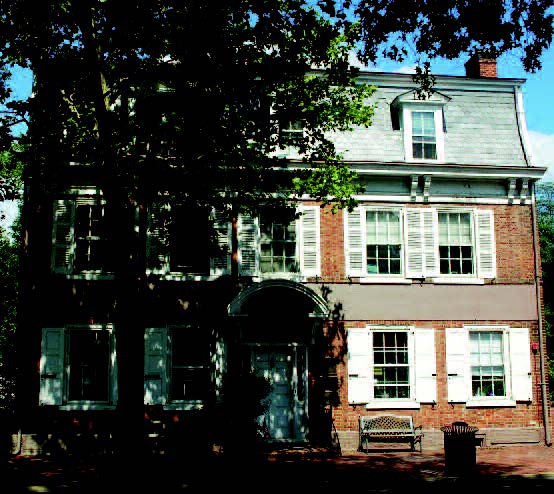
Photo by Susan Kaufmann, Hidden New Jersey/HiddenNJ.com
Listed in the National Register of Historic Places is the Francis Hopkinson House (right), a three-story architectural gem. A signer of the Declaration of Independence, barrister, poet, musician and scientist—and close friend of George Washington—Hopkinson, after studying at Oxford, returned to the colonies to be the first student enrolled in the University of Pennsylvania. He was a fierce patriot who lent more than a casual hand that frosty January night on which those legendary kegs were launched; he also penned the popular tune that commemorated the event.
 PAINT THE TOWN RED
PAINT THE TOWN RED
Bordentown hosts a full calendar of events from May through October, including the Cranberry Festival, which takes place on October 5th and 6th. The festival draws thousands of people and features handmade crafts, original art, a classic car show and a wide range of gourmet and artisan foods. The restaurant scene in Bordentown is always vibrant, as is the shopping in downtown. History buffs are likely to find the city very walkable and decidedly un-touristy. Many visitors opt for a self-guided walking tour; an excellent one can be downloaded at downtownbordentown.com.
An accomplished student of heraldry, Hopkinson, at Washington’s request, designed our nation’s first flag. The stars he took from Washington’s coat of arms, the stripes from his own family’s coat of arms. Philadelphia’s Betsy Ross is credited with having sewn our first flag. But it was designed by Frances Hopkinson and formally adopted by the Second Continental Congress on June 14, 1777, a date commemorated nationwide today by our June 14 celebration of Flag Day.

Photo courtesy of Re/Max Real Estate
Just across the street is the Joseph Borden House (see page 15). It was rebuilt in 1778 after the British stormed and sacked the town, burning the original Borden House to the ground. Borden gave his name to the town where he owned the cooperage from whence came the kegs sent down the Delaware to terrorize the British navy. He also established a vital rail link (right) that provided safe travel from Philadelphia, via Bordentown, to Perth Amboy and then by ferry to New York. It was, in the late 18th, early 19th centuries, in terms of travel convenience, the equivalent of I-95. It also, not so incidentally, made Joseph Borden a very wealthy man.

National Museum of American History
Borden and Hopkinson were friends and fellow activists throughout the American Revolution and its tumultuous aftermath. Both men befriended a young transplant from England, Thomas Paine. At the age of 29, Paine journeyed to the Colonies at the behest of his mentor, Benjamin Franklin. He landed in Philadelphia but soon moved to Bordentown, where he built a house on the corner of Church and Farnsworth. Though radically altered, it is still there. In short order, Paine was publishing and distributing pamphlets entitled Common Sense, which advocated independence from England. His pamphlets were avidly read throughout the 13 colonies. Since such writing was highly treasonous (and carried a mandatory sentence of death by public hanging), Paine published anonymously. In 1777 and ’78, he donated all of his earnings to the revolutionary cause. It can fairly be said that George Washington’s army could not have survived its first six months had it not been for Paine’s financial aid. A charming statue (above) commemorating Paine’s days as a staunch patriot graces a carriage turn-around in a leafy park overlooking the Delaware.
It would be a mistake to think that Bordentown’s historical bona fides rest exclusively with the revolutionary era. In 1813, Napoleon Bonaparte’s older brother, Joseph Bonaparte, named King of Spain by his emperor brother, was stripped of the monarchy by a disaffected populace and forced into exile. Banished from France, unwelcome in England, he found his way to America. Political connections took him from New York to Philadelphia. Amorous connections took him from Philadelphia to Bordentown. There, on an estate called Point Breeze overlooking the Delaware, he had ten miles of carriage paths built and imported countless rare botanical specimens. He built an artificial lake, just right for winter skating and summer dips, and stocked it with French swans. The residence was a wonder of marble fireplaces, sweeping staircases, a vast wine cellar and a library of more than 8,000 books. At Point Breeze, the ex-King of Spain entertained many notables of the day, heads of state, prominent financiers, and internationally acclaimed musicians, authors and artists. With his American love, Annette Savage—fondly known as Madame de la Folie—Joseph Bonaparte fathered two American daughters.
In 1815, when the place was devastated by fire, the townspeople arrived en masse to help salvage as much as possible from the blaze. Reflecting back on that disaster Joseph wrote:

Photo credit: The History Girl/HistoryGirl.com
“Everything that was not consumed, has been most scrupulously delivered into the hands of the people of my house. In the night of the fire, and during the next day, there were brought to me, by laboring men, drawers, in which I have found the proper quantity of pieces of money, and medals of gold, and valuable jewels, which might have been taken with impunity. This event has proved to me how much the inhabitants of Bordentown appreciate the interest I have always felt for them; and shows that men in general are good…”
Of its glory days as home to European royalty, Bordentown today retains only the handsome wrought-iron gates that were the entrance to Breeze Point. Splendid horse-drawn carriages no longer use the lovely turn-around where Tom Paine in bronze stands, pamphlets in hand. Commercial river traffic, once the town’s prime source of revenue, has given way to weekend kayakers, fishermen and mid-summer tubing expeditions. Once a vital hub of colonial transportation, Bordentown is now home base to Ocean Spray Cranberry and corporate headquarters for Prince Tennis Racquets. Yet, as Patti Desantis likes to remind the history-hungry visitors who find their way to Bordentown, it is the town’s lineage, so lovingly preserved despite the relentless pressures of modernism, that makes Bordentown unique among New Jersey’s rich store of tourist attractions.
If you haven’t tried these 20 amazing culinary treasures, then you have yet to experience the full flavor of our state
Photography by Daryl Stone
New Jersey, the bountiful. Our swaths of fertile farmland, our seafood-rich ocean and bays, our orchards ripe with fruits, our bogs famous for berries. And, most of all, our people, diverse and devoted to personal heritage, serving forth the foods of their ancestors and imaginations. Don’t knock New Jersey’s culinary riches when I’m within earshot, because I’m armed with decades of eating experiences that I’ll use to bring you down.
Here’s my thinking, based on 50 years of Jersey-centric chowdowns: I wanted to make this list about the Jersey I knew as a kid, growing up in Somerset County, and I wanted to make it about the Jersey I have watched my home state become during the 25 years I’ve written about food. I wanted this list to reflect New Jersey’s food culture, past and present. I wanted to touch as many diverse facets of New Jersey’s eating culture as possible. Most of all, I wanted this list to reflect high quality, in humble and haute form.
I also wanted it to be fun. To that end, it mixes restaurants fancy and super-casual. It sports specific ingredients and icons. It taps into the ethnic riches that bring us a veritable United Nations of eating opportunities. It spans the length and width of the state and taps places famous and little known. It spotlights foods I’ve been eating since I was a kid and a couple I’ve only just come to know.
Do you have additions to this list? Bring them on…because they’re all likely places I had to, with regret and remorse, 86 from this list of 20 in order to whittle it down to the ultimate must-eats in the Garden State…
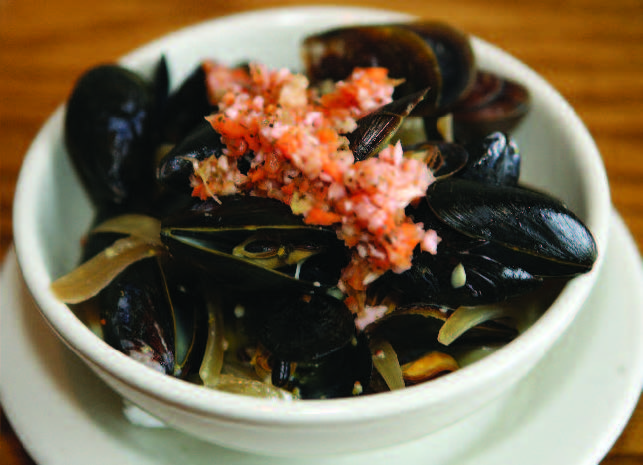 A Toute Heure • 232 Centennial Ave. • Cranford 908-276-6600 • atouteheure.com
A Toute Heure • 232 Centennial Ave. • Cranford 908-276-6600 • atouteheure.com
With 85 farms fortifying the kitchen, it’s no wonder the chefs at this true bistro of local ingredients seem to have an endless repertoire of gorgeous, delicious dishes. But it’s the menu’s list of “Mussel Pots” that brings me to my knees, mussels done both seasonally and soulfully, in portions with or without frites. Farm-to-table is what A Toute Heure is about, but the exquisite simplicity of its plates feeds my soul.
Alba Vineyards • 269 Route 627 • Finesville • 908-995-7800 • albavineyard.com
Alba, located in bucolic Warren County near the border of Hunterdon, is home to some of the most lauded wines on the East Coast. It’s a must-stop on any Jersey countryside tour, and it’ll have you plotting a move, if you live in a suburban or urban locale. Make sure to tote home Alba’s divine Red Raspberry Wine, for this dessert replacement/enhancement is nothing short of world class.
Allen’s Clam Bar • 5650 Route 9 • New Gretna •609-296-4106 • no web site
Ever since I first encountered the French Fried Lobster Tail at Allen’s, I’ve been curious about how the ’tails served here could be so large. I’m not exactly lightheaded when I eat them, usually having polished off some steamed clams and chowder, but I still can’t quite wrap my head around their size. There might be culinary chicanery of some sort, but I’ll keep doing what’s necessary to get to the bottom of this exceptional partnership of the sea king and expert deep-frying.
ARC Greenhouses/Mr. McGregor’s Greens & Herbs 440 Oak Road • Shiloh • 856-451-8800 • arcgreenhouses.com
If you’re lucky enough to come across the Mr. McGregor’s brand of greens in a specialty market, buy them. Don’t think, buy. In a vast expanse of meticulously farmed greenhouses in South Jersey’s Shiloh, the best greens sprout and then are snatched up by some of the region’s top chefs. There’s all manner of produce, but the little guys—peppercress, wasabi mustards, red amaranth—turn me into a hungry rabbit.
 Aunt Charlotte’s • 3 West Maple Ave. • Merchantville • 856-662-0058 • auntcharlottescandy.com
Aunt Charlotte’s • 3 West Maple Ave. • Merchantville • 856-662-0058 • auntcharlottescandy.com
Pretty, hand-painted chocolate, nonpareils, choice truffles—art meets sweet at this fourth-generation temple of confections, where folks make pilgrimages to fulfill their kids’ holiday wishes. There’s nothing not worth the indulgence, though there’s one item that likely will exceed expectations: Aunt Charlotte’s malted milkballs. Multiple layers take this humble candy-counter regular to dazzling heights of flavor you won’t believe till you try.
Cucharamama • 233 Clinton St. • Hoboken • 201-420-1700 • cucharamama.com
James Beard Best Chef Award-winner Maricel Presilla is not just a celebrated chef, but a scholar, a former Rutgers professor and culinary historian who specializes in the foods of Latin America and Spain. (Her “Grand Cocina Latina” won top honors in cookbooks at last year’s Beard Awards, cementing her place in the food world’s pantheon of superstars.) Her restaurant? Oh, it’s all that—and more. Eat through her menu and you’ll earn a doctorate in Latin foods. At the end of your “studies,” plan a feast with friends around Presilla’s roast suckling pig. A triumph of tradition.
 Drew’s Bayshore Bistro • 25 Church St. • Keyport • 732-739-9219 • bayshorebistro.com
Drew’s Bayshore Bistro • 25 Church St. • Keyport • 732-739-9219 • bayshorebistro.com
Chef-owner Drew Araneo, a multiple James Beard Award nominee, has a heartfelt menu of dishes inspired by New Orleans and Southern cookery. After trouncing Bobby Flay in “Throwdown,” Araneo and his signature dish winner Voodoo Shrimp became famous beyond Jersey’s borders. Justifiably so. Fans can’t resist ordering it time after time after time. Including me.
El Tule • 49 North Main St. • Lambertville • 609-773-0007 • eltulerestaurant.com
A Mexican-Peruvian combo, this Latin destination sports splendid takes on classics as well as more modern interpretations. I find myself in the mood for one or the other every time I eat here, but lately I’m leaning Peruvian: any of the ceviches, so resoundingly fresh, any of the quinoa dishes, particularly the Solterito de Quinoa salad, sprightly with vegetables and popping with the grain’s inherent nuttiness. Where has this food been all my life?
The Flaky Tart • 145 First Ave. • Atlantic Highlands • 732-291-2555 • theflakytartnj.com
The pastries, the cakes, the cookies, the buns, the mousse-y things whirled into artfully angular cups, the sandwiches on croissants, the quiches—oh, everything the lovely and talented pastry queen Marie Jackson does at the mecca she calls “the bakery” is sublime. But here’s a tip: Whenever the “Kerry Nolan Scone” is on tap, grab it. In fact, grab however many Kerrys there are. It’s a scone made of bacon, Cheddar, maple and apple, and it was great cook Kerry’s dream. (Name sound familiar?Kerry’s the morning news host on WQXR in New York.)
 Jhupdi • 1679 Oak Tree Road • Edison • 732-906-2121 • jhupdirestaurant.com
Jhupdi • 1679 Oak Tree Road • Edison • 732-906-2121 • jhupdirestaurant.com
One of the largest South Asian/Indian populations in America lives in and around this Middlesex County municipality, where there’s a wealth of Indian eateries. I’m invariably charmed by this South India specialist and its irresistible Thali platters, which offer a panoply of vegetarian selections from the state of Gujarat. Go for lunch one day, try a couple of the Thali platters, and find yourself wishing for seconds of bajri rotla and baigan bharta. And the cauliflower? Oh, my.
Melick’s Town Farm • 170 Oldwick Road • Oldwick • 908-439-2955 • melickstownfarm.com
In the late summer of 1977, farmer-freeholder George Melick introduced me to a white peach—one from his orchards in the village of Oldwick that date back to 1725. Eating that succulent peach changed my life. George and his wife, Norma (“Try a Jonathan apple, Andy”), opened a world of produce possibilities for me. They’ve done the same for generations of New Jerseyans. Now, with children Peter, John and Rebecca running the 650 acres they own (including 120 acres sporting 5,000 peach trees and 20,000 apple trees), the fruits of the Melicks’ labors continue to feed and educate.
 Mitsuwa Marketplace • 595 River Road • Edgewater • 201-941-9113 • mitsuwa.com
Mitsuwa Marketplace • 595 River Road • Edgewater • 201-941-9113 • mitsuwa.com
What Disneyworld is to a 6-year-old, this Japanese uber-market is to me. Prime produce, fishes, prepared foods, sweets and even an aisle with serious sakes. I’m transported to the Far East and inspired to bring home the ingredients for a feast that, however faintly, mimics Japanese culinary artistry. I snatch up the prepared foods and learn by eating at home.
Mustache Bill’s Diner • Eighth Street & Broadway • Barnegat Light • 609-494-0155 • no web site
The first time I had a fried flounder sandwich at this landmark at the northern end of Long Beach Island, I was riveted. The fish was pristine, the frying flawless. Even the tartar sauce hit the mark. That’s because owner Bill Smith buys that flounder right off the boats, from the island’s fishing fleet. In fact, everything at this diner is homemade, except for the French dressing. (Ah, the “why” of that’s a long story.) No wonder this place won a coveted James Beard America’s Classic Award.
Nasto’s Ice Cream • 236 Jefferson St. • Newark • 973-589-3333 • nastosicecream.com
Born in 1939 and celebrating its 75th birthday this year, the ice cream king of New Jersey started with old-family recipes of Sicilian-style ices and gelatos and kept pace with its evolving neighborhood. Now there’s mango and sweet corn in the lineup, as well as sea salt caramel and passion fruit. While proprietors Frank Nasto Jr. and Frank Nasto III give a nod to their vanilla, I have to pledge my devotion to my first Nasto’s love, the incomparable Honey-Fig Gelato.
Rat’s Restaurant • 16 Fairgrounds Road • Hamilton • 609-584-7800 • ratsrestaurant.com
Named for the hospitable character Rat in the childhood classic “Wind in the Willows,” sculptor and Rat’s mastermind J. Seward Johnson’s pet book, this French-inspired spot is set in the Grounds for Sculpture’s Giverny-esque landcape. Sunday brunch, a grand buffet that elegantly defies the same-old, same-old norm, is prime time to fuel on fare both modern and comforting, then stroll through an artful wonderland that hasn’t, and can’t be, duplicated anywhere else.
Shanghai Bun • 952 Route 34/Matawan Mall • Matawan • 732-765-8388 • Shanghaibunmatawan.com
Chinese eateries abound in New Jersey. But Shanghai Bun is different, because of its Beef Sandwich. A few slabs of thinly sliced veined beef on a seeded bun that’s neither a burger bun nor a flatbread are spread with a secret sauce that’s a little soy and a little sweet and then topped with skinny batons of something allium and a flourish of fresh cilantro. It’s an enigmatic sandwich that enchants every time.
Valley Shepherd Creamery • 50 Fairmount Road • Long Valley • 908-876-3200 • valleyshepherd.com
A visit to the Sheep Shoppe at this expansive, idyllic farm deep in the Morris County countryside may well net you cheeses for a year. Or, if you’re like me, cheeses that should last a year but don’t stretch for a week. Valley Thunder? Tewksbury? A tomme or wedge flecked with nettles? OK, it’s agony, but I’ll go with…my original favorite, Oldwick Shepherd.
White House Subs • 2301 Arctic Ave. • Atlantic City • 609-345-8599 • whitehousesubshop.net
Since 1946, this little sub shop has been putting to shame anyone who thinks slapping meat on bread is making a proper sandwich. The folks here hollow out the sub rolls, they calculate the right ratio of meat to cheese to bread to condiments. They are scientists and artists. They make the one and only White House Special, with extra salami, provolone, ham and capocollo. They are New Jersey.
White Manna • 358 River St. • Hackensack • 201-342-0914 • no web site
The slider-size cheeseburgers on potato rolls energized with a slap or seven of sautéed onions are meant to be ordered in threesomes. If you order fewer, you’ve either just had gastric bypass surgery or really don’t enjoy eating. There are fine burgers throughout New Jersey, but these little gems have a singularly sensational flavor, the perfect coming together of beef, bun and condiments. Plus, the close-clustered space surrounding the sushi-counter-like center of operations is pure community.
Zeppoli • 618 Collings Ave. • Collingswood • 856-854-2670 • zeppolirestaurant.com
So where’s the Jersey Tomato on this list, you ask? Well, it’s a sad fact that too many of our farmed tomatoes today are being picked unripe and shipped out of state. But anything with tomatoes here at chef Joey Baldino’s peerless Sicily-centric Italian restaurant is worth ordering. And anointing for saintly qualities. I’m remembering the Panzanella Catania, a tomato-and-bread salad, with capers and a correct proportion of white anchovies. Bliss. Lucky us that Baldino left Philly for this side of the Delaware.
 BLUE BY YOU
BLUE BY YOU
The Jersey Blue-Claw Crab, popping out of Jersey waters not far from you this summer. When the meat is sweet and the claws are fat with that meat, happiness is a certainty. What can you do with the crabmeat that our fisherfolk work so hard to catch? Make a sauce, with our Jersey tomatoes, and toss with pasta; make a salad, with our Jersey greens and lettuces; make a cake, with spices scored from our ethnic markets. Or eat it straight, as I do.
Editor’s Note: New Jersey’s bounty is both enviable and endless. We hope this list inspires you to make one of your own—and share it with us on our Facebook page.
What is it about northern New Jersey that produces so much show business talent? Is it a numbers game, as some claim, a result of so many people per square mile? Is it the restlessness engendered by urban sprawl, the need to move up and move out? Is it the nighttime skyline of New York City, twinkling in the distance, coaxing our hidden gems across the river? EDGE’s Gerry Strauss sat down with actor Jason Biggs to explore these questions, and to chart his course from child actor to movie franchise star to his most recent turn as a member of the spectacular ensemble cast of the Netflix hit Orange Is the New Black. What’s on the horizon for Biggs? Spoiler alert: It won’t be Guys and Dolls.
EDGE: From a career perspective, was there a benefit to growing up in Hasbrouck Heights, in terms of the proximity to New York?

Photo by Linda Kallerus for Netflix.
JB: Without a doubt. In fact, if I had not grown up where I did, it stands to reason that I might never have gotten into show business at all. As it was, it was just eight miles between my house and Times Square. Our patience was tested plenty, fighting the rush hour traffic at the Lincoln Tunnel when I had an after-school audition. But had I lived any further away, I can’t imagine that working and auditioning in the city would have been plausible.
EDGE: Aside from the acting, was your childhood fairly typical?
JB: I played Little League baseball, Pop Warner football, and wrestled with the town recreational team. I rode my bike everywhere, swam in our pool during the humid summers, and shoveled snow for neighbors in the winter. We lived right under the flight paths for both Teterboro and Newark airports, and I would spend countless hours sitting outside, watching and identifying the planes overhead. In fact, I remain obsessed with aviation as an adult.
EDGE: How did acting find its way into the mix?
JB: My older sister, who is six years my senior, was in a dance group as a kid. Some of the other girls in the group started going into the city to try to get agents and attempt acting. My sister wanted to do the same. Our parents, thinking it could be both a fun hobby and a good way to save money for college, supported it and made it happen. When I was five, my sister’s then-manager called my mom and asked if I would want to audition for something. I did, and haven’t stopped since.

Photo by Ali Goldstein for Netflix.
EDGE: What role did your parents play in your evolution as an actor?
JB: My parents were instrumental in making it possible for me to act as a child. Logistically speaking, there was no way I could have done it without their services as chauffeurs and chaperones. But they never forced it on me—it was always my choice. They were very proud of my accomplishments as a kid, just as they are now.
EDGE: At 14, you were on Broadway with Judd Hirsch and Tony Shaloub in Conversations with My Father, and at 16 you were on As the World Turns. What did you carry forward from those early experiences as an actor?
JB: I like to think that every job I have helps prepare me for the next one. But daytime television certainly had its challenges and gave me important lessons to take into future jobs. For example, the filming schedule in daytime moves at a breakneck speed. As such, you need to be very capable when it comes to quickly and efficiently memorizing all of your lines. You don’t have much time for rehearsal. You really learn to focus and think quickly.
EDGE: You are so well known for the R-rated coming-of-age American Pie films, which continue to have an incredible following. What do you think the movie’s ultimate legacy will be?
JB: Well, it’s obviously somewhat difficult to be objective about something that I am so close to, and that is such an integral part of my life. But based on people’s reactions—and to the constantly changing demographic of the movie’s fans—I believe it will have great staying power. I look forward to helping many future generations of adolescents learn about the birds and the bees!
EDGE: On the flip side, playing the same character in a hit movie with three hit sequels is a risky proposition for anyone who thrives on playing diverse characters. How important was it for you to pursue roles where people could see you differently than they knew you from American Pie?
JB: I’m always trying to change people’s perception of me, especially since that perception is pretty firmly attached to one role in particular. I know that I am a more complicated and multi-faceted person than I’ve been able to show in my roles, so of course I’m eager to share that. But really, the bigger point in trying to branch out is to keep things exciting for me and to continue to challenge myself by working outside my comfort zone. Ultimately, I’m grateful for any opportunity to work. This is a very fickle industry—one in which it is tough to find success, let alone maintain it.
EDGE: Was it tough to know that the world was basically watching you grow up?
JB: Truthfully, it wasn’t something I was aware of while it was happening. I’m more aware of it now though. Looking back at the footage, I can’t help but be struck by how young I look. It’s been over 15 years since the first American Pie. Of course, I thought I was such an adult then, but I obviously had so much still to learn.
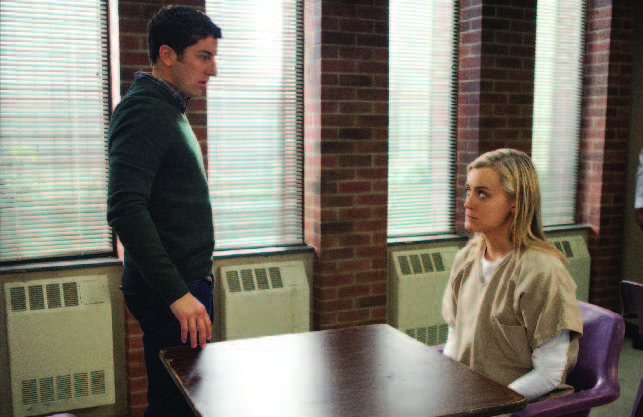
Photo by K.C. Bailey for Netflix.
EDGE: Your body of work is eclectic, to say the least. From drama to comedy to voiceovers to small films. What do you look for in a role?
JB: I look for an opportunity to have fun, to challenge myself, and to work with great people. I’ve been very lucky in my career to have been able to move across different genres and different mediums, and work with people who I can learn a lot from. Ideally, every job will feel like it’s an organic next step in my career, one that will hopefully continue into the future.
EDGE: Your current show, Orange Is The New Black, is unique not just in terms of story and tone, but in the fact that it’s part of the Netflix library of original programming—with no actual presence on traditional broadcast or cable television. It sounds as if that uncharted aspect of the project might have been appealing.
JB: There is no question that a huge part of the appeal of the project was the fact that it would be streaming on Netflix. The entire television landscape has changed dramatically over the last few years. The way people consume their shows and movies is different. And Netflix is at the forefront of the movement to cater to these new demands. I feel like I’m part of something groundbreaking, something cutting-edge. It’s very cool.
EDGE: What’s different about shooting a series that’s released all at once, where people can binge watch or watch on their own schedule?
JB: What makes this model most unique—both because we shoot the whole season in its entirety and it is released in its entirety—is that it makes it more akin to a 13-hour movie, as opposed to a television show. This affects the actors on set and, as you point out, also the audience at home.
EDGE: Your character on the series, Larry Bloom, exists in real life. For you, is it more important to be accurate or entertaining?
JB: The show’s creator, Jenji Kohan, was clear from the beginning that we would be making our own show, one that could stand apart from the book and therefore from the real lives of the characters in it. It’s a necessity, really, since we are making a longer-form version of the original story—and therefore need to expand upon the original, both in storylines and ideas. So there was no real pressure on me to portray Larry in any other way than that which was dictated by the scripts. I never needed to do an “impression,” so to speak.
EDGE: Orange Is The New Black has such a talented ensemble, headed by Taylor Schilling (above left). Is there a hidden gem in the cast, one actor or performance that has really taken you by surprise?
JB: Well, it’s hard to single out one performance. This entire cast is pretty special. But the character of Tiffany “Pennsatucky” Doggett has always been a favorite of mine. Taryn Manning’s portrayal is both hilarious and heartbreaking.
EDGE: What is your own hidden gem? If you could point EDGE readers to one performance you’re particularly proud of, which would it be?

MRB Productions/Votiv Films
JB: Grassroots is a film and performance I am particularly proud of. Not unlike Orange, it required a more subtle, grounded, and emotionally true performance. It’s a cool little film that represents for me a turn toward choosing more challenging and adult roles.
EDGE: Do you still maintain any connection to your old stomping grounds in Jersey?
JB: Very much so. My parents live in the same house I grew up in. My sister lives in Bogota. I’ve remained friends with a lot of my buddies from high school, some of whom still live in North Jersey as well. I try to get back a couple times a year, and I always make it to at least one Giants game each season. They’ll always be my team, no matter where I might live.
EDGE: What aspect of Jersey life have you clung to?
JB: Well, my dietary habits remain firmly tied to my Italian-American-North-Jersey upbringing. I love cooking pasta for early Sunday dinners, for example. And my accent is likely to make the occasional appearance, especially when I’m having a conversation with one of my family members or friends from home. My wife always points it out when that happens. Fortunately for me, she thinks it’s cute.
EDGE: You’ve done so many things already in your career, but what would you like to do that you’ve never done before?
JB: Tough question. It sounds trite, but I really want to try it all—except for the things I absolutely know for certain I will never be able to do. Like singing. So don’t expect to see me in Guys and Dolls anytime soon. And if you hear that I’m in a production of it, definitely don’t go see it. It will be a waste of your money. It’s good to know your limitations, I suppose.

